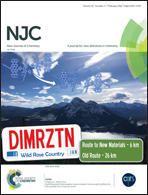Selectively oxidized carbon nanocatalysts for the oxidation of cis-cyclooctene†
Abstract
In this work, selectively oxidized carbon nanotubes and graphene flakes were used as carbocatalysts in the mild oxidation of cis-cyclooctene. Firstly, the multi-walled carbon nanotubes and graphene flakes were oxidized using three different oxidation procedures: (i) nitric acid treatment; (ii) nitric acid followed by thermal treatment at 400 °C; (iii) gas phase oxidation with O2, and subsequently characterized by several techniques. Both oxidized nanomaterials showed an overall increase in the oxygen content and revealed that the different oxidation procedures promoted different superficial chemical compositions: nitric acid treated carbon nanotubes and graphene flakes (respectively, MWCNTh and GFh) presented increased amounts of carboxylic acids, anhydrides and phenols up to 552, 84, and 648 μmol g−1, respectively, for material MWCNTh, and 612, 120, and 1392 μmol g−1, respectively, for material GFh; the nanomaterials treated with nitric acid followed by thermal treatment at 400 °C (MWCNTht and GFht) presented a loss of carboxylic acids and an increase in carboxylic anhydride content (36 and 132 μmol g−1, respectively, for material MWCNTht, and 36 and 156 μmol g−1, respectively, for material MWCNTht), when compared to the nitric acid treated materials MWCNTh and GFh; and finally the gas phase treated nanomaterials, MWCNTo and GFo, presented an increase in the amounts of phenols, carbonyls/quinones, and lactones up to 720, 216, and 144 μmol g−1, respectively, for material MWCNTo, and 804, 420, and 144 μmol g−1, respectively, for material GFo. The carbon nanocatalysts showed activity in the selective oxidation of cis-cyclooctene to epoxycyclooctane using mild conditions: hydrogen peroxide was used as oxidant at 80 °C. The modifications introduced in the pristine materials through nitric acid followed by thermal treatment at 400 °C originated the nanocatalysts with the best activity and selectivity: MWCNTht presented 47% of substrate conversion and 79% epoxycyclooctane selectivity whereas GFht showed 57% conversion and 85% epoxycyclooctane selectivity. Reusability experiments revealed no loss of catalytic activity up to three catalytic cycles. The results indicate that the fine tuning of the carbon nanomaterials through appropriate oxidation procedures is crucial in achieving metal-free carbocatalysts with enhanced performance and selectivity in selective oxidation reactions.



 Please wait while we load your content...
Please wait while we load your content...